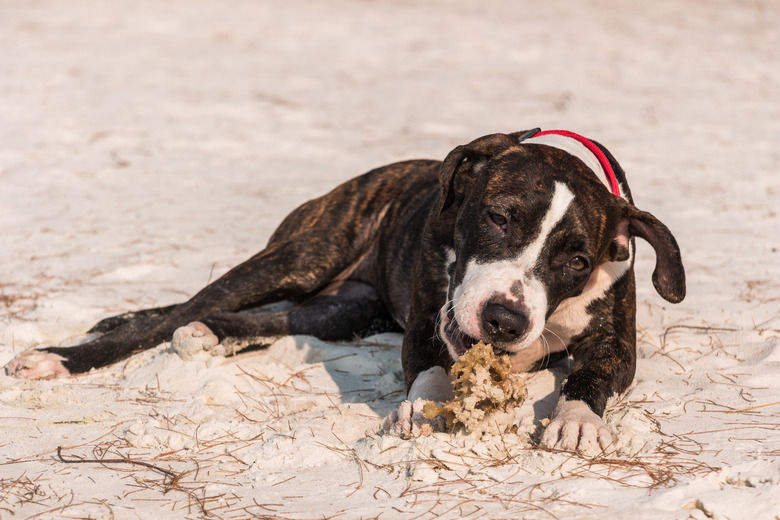How To Make My Pit Bull Puppy Gain Weight
Puppies are known for their fat little bellies, rolls of skin, and roly-poly silhouettes. Healthy puppies don't usually need help to gain weight, and causing your pet to gain too much weight too quickly can be unhealthy in the long run. To help your healthy pit bull puppy maximize her growth and muscle-building potential, feed her a quality nutritional diet, build muscle through exercise, and consider adding a pit bull muscle-builder supplement.
How pit bulls grow
How pit bulls grow
As pit bulls grow, they can go through phases where their rapid growth makes them appear skinny or pudgy. Knowing how much your pit bull should weigh at each stage of life is essential to help him maximize his growth and weight potential without creating unhealthy obesity.
Adult American pit bull terriers vary in size, with breed standard weights ranging from 35 to 60 pounds for males and 30 to 50 pounds for females. American Staffordshire terriers — another breed commonly thought of as pit bulls — are a bit bigger, with adult males ranging from 55 to 70 pounds and females at 40 to 55 pounds.
Get familiar with your dog's lineage to know how big your dog should be and if he is overweight or underweight at each stage of his life. An American pit bull terrier, for example, should never weigh 70 pounds. Check a pit bull growth chart to make sure you're not making your pit bull fat. On average, your pup should not gain more than 2.5 pounds per week.
Nourish the pit bull runts
Nourish the pit bull runts
Pit bulls are born into litters that average five puppies%20up%20to%2010%20pups!). However, litter size ranges from a single pup to 10 puppies. In a large litter, the mom can't necessarily feed every puppy at once, as they have on average five to seven nipples (although they could have as many as 10). This means that stronger pups will shoulder weaker ones out of the way, and the mother dog might not have enough milk left once the smaller ones get to the nipple.
If you have a litter of puppies with one or more runts, you will need to give them extra care to make sure they're getting proper nutrition. Move them close to the mom's nipple and protect them from other pups trying to jostle them aside. If the mom doesn't want to feed them or she's not producing enough milk for all, get a milk replacement formula from your veterinarian and give the runts supplemental feedings on the side.
If your runt pups don't gain weight in the first 24 to 48 hours, have them checked by a veterinarian. Puppies have a hard time regulating their body heat and have an underdeveloped immune system that could keep them weak. It's important to take action early, as fading puppy syndrome can kill a pup in her first weeks of life.
At what age do pit bulls get muscular?
At what age do pit bulls get muscular?
As your pup reaches about 4 months old, he will begin to lose his roly-poly look and develop the renowned pit bull muscular structure. The next four months will be a time of rapid growth before the growth rate begins to slow at about 8 months old. Your pitty will continue gaining weight after he reaches a year old as he reaches his full size but continues filling out with muscle.
Support your dog's natural muscle growth by feeding him a high-quality, nutritious diet rich in high-quality protein, a moderate amount of fat, and a lower amount of carbs. The protein in the dog food should list whole ingredients, such as chicken, beef, or lamb — not byproducts. High-quality fat and carbs should come from whole foods, like chicken, fruits, and vegetables. Don't give supplemental fat, such as bacon grease, to help your dog gain weight because the unhealthy fats and sodium can cause pancreatitis.
Build muscles by providing your dog with enough exercise, such as long walks or stair climbing. Swimming is another excellent exercise but be sure to keep sessions to 10 minutes and build up your dog's endurance slowly. Exercising your dog too long or in cold water can cause a painful condition known as swimmer's tail. Also known as limber tail, symptoms include a limp, drooping tail caused by your dog overusing his tail as a rudder in the water. It usually clears up in a couple of days with rest.
References
- United Kennel Club: American Pit Bull Terrier Official UKC Breed Standard
- American Kennel Club: American Staffordshire Terrier
- SpiritDog: How Many Puppies Can a Pitbull Have?
- Dog Leash Pro: How Many Nipples Do Dogs Have?
- Bil-Jac: Monitoring a Healthy Weight for Your Puppy
- Canine Bible: Runt of The Litter: Meaning, Health, Personality, Care & FAQs – Is It Bad to Get A Runt Puppy?
- VCA Hospitals: Fading Puppy Syndrome in Dogs
- Terrier Owner: What Age Do Pitbulls Reach Full Size [Growth Chart & Facts]
- Dog Advisory Council: Pitbull Muscle — How to Make a Pitbull Muscular? (What to Feed and Exercises)
- Ducks Unlimited: A Lesson in Limber Tail
